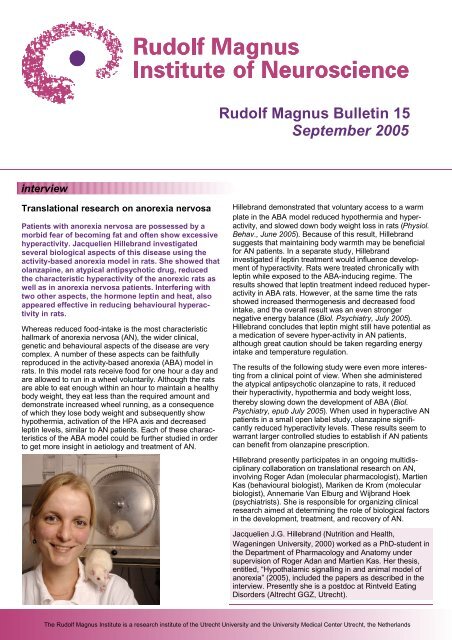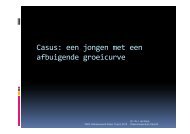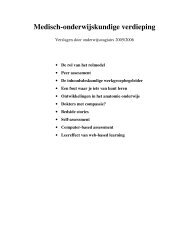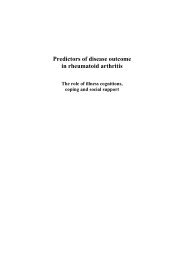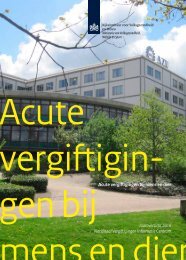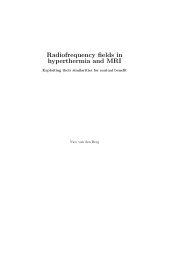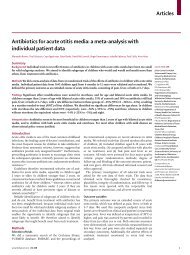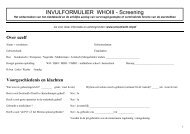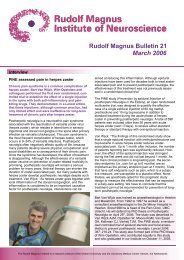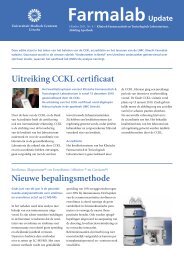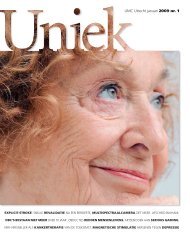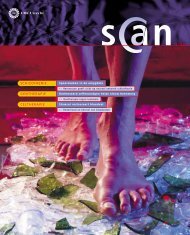Rudolf Magnus Bulletin 15 September 2005 - UMC Utrecht
Rudolf Magnus Bulletin 15 September 2005 - UMC Utrecht
Rudolf Magnus Bulletin 15 September 2005 - UMC Utrecht
Create successful ePaper yourself
Turn your PDF publications into a flip-book with our unique Google optimized e-Paper software.
<strong>Rudolf</strong> <strong>Magnus</strong> <strong>Bulletin</strong> <strong>15</strong><br />
<strong>September</strong> <strong>2005</strong><br />
interview<br />
Translational research on anorexia nervosa<br />
Patients with anorexia nervosa are possessed by a<br />
morbid fear of becoming fat and often show excessive<br />
hyperactivity. Jacquelien Hillebrand investigated<br />
several biological aspects of this disease using the<br />
activity-based anorexia model in rats. She showed that<br />
olanzapine, an atypical antipsychotic drug, reduced<br />
the characteristic hyperactivity of the anorexic rats as<br />
well as in anorexia nervosa patients. Interfering with<br />
two other aspects, the hormone leptin and heat, also<br />
appeared effective in reducing behavioural hyperactivity<br />
in rats.<br />
Whereas reduced food-intake is the most characteristic<br />
hallmark of anorexia nervosa (AN), the wider clinical,<br />
genetic and behavioural aspects of the disease are very<br />
complex. A number of these aspects can be faithfully<br />
reproduced in the activity-based anorexia (ABA) model in<br />
rats. In this model rats receive food for one hour a day and<br />
are allowed to run in a wheel voluntarily. Although the rats<br />
are able to eat enough within an hour to maintain a healthy<br />
body weight, they eat less than the required amount and<br />
demonstrate increased wheel running, as a consequence<br />
of which they lose body weight and subsequently show<br />
hypothermia, activation of the HPA axis and decreased<br />
leptin levels, similar to AN patients. Each of these characteristics<br />
of the ABA model could be further studied in order<br />
to get more insight in aetiology and treatment of AN.<br />
Hillebrand demonstrated that voluntary access to a warm<br />
plate in the ABA model reduced hypothermia and hyperactivity,<br />
and slowed down body weight loss in rats (Physiol.<br />
Behav., June <strong>2005</strong>). Because of this result, Hillebrand<br />
suggests that maintaining body warmth may be beneficial<br />
for AN patients. In a separate study, Hillebrand<br />
investigated if leptin treatment would influence development<br />
of hyperactivity. Rats were treated chronically with<br />
leptin while exposed to the ABA-inducing regime. The<br />
results showed that leptin treatment indeed reduced hyperactivity<br />
in ABA rats. However, at the same time the rats<br />
showed increased thermogenesis and decreased food<br />
intake, and the overall result was an even stronger<br />
negative energy balance (Biol. Psychiatry, July <strong>2005</strong>).<br />
Hillebrand concludes that leptin might still have potential as<br />
a medication of severe hyper-activity in AN patients,<br />
although great caution should be taken regarding energy<br />
intake and temperature regulation.<br />
The results of the following study were even more interesting<br />
from a clinical point of view. When she administered<br />
the atypical antipsychotic olanzapine to rats, it reduced<br />
their hyperactivity, hypothermia and body weight loss,<br />
thereby slowing down the development of ABA (Biol.<br />
Psychiatry, epub July <strong>2005</strong>). When used in hyperactive AN<br />
patients in a small open label study, olanzapine significantly<br />
reduced hyperactivity levels. These results seem to<br />
warrant larger controlled studies to establish if AN patients<br />
can benefit from olanzapine prescription.<br />
Hillebrand presently participates in an ongoing multidisciplinary<br />
collaboration on translational research on AN,<br />
involving Roger Adan (molecular pharmacologist), Martien<br />
Kas (behavioural biologist), Mariken de Krom (molecular<br />
biologist), Annemarie Van Elburg and Wijbrand Hoek<br />
(psychiatrists). She is responsible for organizing clinical<br />
research aimed at determining the role of biological factors<br />
in the development, treatment, and recovery of AN.<br />
Jacquelien J.G. Hillebrand (Nutrition and Health,<br />
Wageningen University, 2000) worked as a PhD-student in<br />
the Department of Pharmacology and Anatomy under<br />
supervision of Roger Adan and Martien Kas. Her thesis,<br />
entitled, “Hypothalamic signalling in and animal model of<br />
anorexia” (<strong>2005</strong>), included the papers as described in the<br />
interview. Presently she is a postdoc at Rintveld Eating<br />
Disorders (Altrecht GGZ, <strong>Utrecht</strong>).<br />
The <strong>Rudolf</strong> <strong>Magnus</strong> Institute is a research institute of the <strong>Utrecht</strong> University and the University Medical Center <strong>Utrecht</strong>, the Netherlands
PhD theses<br />
<strong>2005</strong>-24<br />
<strong>September</strong> 7, <strong>2005</strong><br />
S.I. Correia de Oliviera Santos<br />
Seeing the invisible<br />
B.A. Van Oost, J.T. Lumeij<br />
Supervisors<br />
<strong>2005</strong>-25<br />
Attention on pain<br />
<strong>September</strong> 8, <strong>2005</strong><br />
Judy (D.)S. Veldhuijzen<br />
Effects of pain and its pharmacological treatment on<br />
driving ability and cognition<br />
J.L. Kenemans, B. Olivier, C.J. Kalkman, E.R. Volkerts<br />
supervisors<br />
Chronic pain hampers cognitive performance in daily<br />
life of many patients. Judy Veldhuijzen studied the<br />
driving ability of patients suffering from chronic pain<br />
and the influence of psychotropic medication on<br />
driving, as well as the interaction between chronic or<br />
experimental pain and attention. Pain patients had<br />
difficulties focussing their attention both in automated<br />
tasks like driving and in controlled cognitive laboratory<br />
tasks. Medication with amitriptyline in some<br />
conditions worsened the performance of pain patients,<br />
warranting further safeguarding of its use.<br />
Veldhuijzen used a specially adapted car to assess the<br />
driving abilities of sufferers of chronic pain and the effect of<br />
medication. Patients were asked to drive a standard<br />
highway track of 100 km in real traffic at a constant speed<br />
of 95 km/h in the centre of the right lane. A driving<br />
instructor with access to dual controls safeguarded the test<br />
drive. The deviations from the centre position in the lane<br />
were taken as readout for the ability to drive safely.<br />
Veldhuijzen found that pain patients drove more unsafely<br />
than controls. Also acute medication with amitriptyline<br />
worsened their driving abilities. However, chronic (> 2<br />
weeks) use of this medication did not alter driving abilities.<br />
Conclusions from these studies are that the effects of pain<br />
on safe driving are generally underestimated and that<br />
changes in medication may also be potentially dangerous.<br />
Car used in driver's test (courtesy of Judy Veldhuijzen)<br />
Car driving is an automated task. Veldhuijzen also tested<br />
the effects of chronic and experimental pain on attention in<br />
non-automated cognitive tasks, using electroencephalography<br />
(EEG) and Event-Related Potentials (ERP). She<br />
tested the effect of pain, induced by immersing the nondominant<br />
hand of healthy volunteers in cold water, while<br />
they were performing a visual location task. It appeared<br />
that the pain perception was attenuated when more<br />
demanding tasks were performed. She also measured the<br />
attention capacity in chronic pain patients in primary visual<br />
tasks that were 'probed' by visual distractors. Healthy<br />
volunteers showed decreasing attention capacity with<br />
increasing difficulty of the test, but chronic pain patients<br />
showed no capacity problems, indicating that the difficultties<br />
that pain patients experience are in focussing their<br />
attention, but are not a capacity problem. Acute administration<br />
of amitriptyline had adverse effects on the reaction<br />
time in patients, but sub-chronic administration had a<br />
positive effect on attention capability.<br />
Judy Veldhuijzen (January 19, 1975, Tiel). Secondary school<br />
(RSG Lingecollege, Tiel), 1994; Psychology at <strong>Utrecht</strong><br />
University, 2000. In 2001-<strong>2005</strong> she worked as a PhD-student at<br />
Psycho-pharmacology (Pharmaceutical Sciences, <strong>Utrecht</strong><br />
University) on the work described in her thesis. As of October 1,<br />
<strong>2005</strong>, she will work as a postdoc at the University of Maryland<br />
(Baltimore, USA).<br />
<strong>2005</strong>-26<br />
<strong>September</strong> 16, <strong>2005</strong><br />
M.C. Toet<br />
Cerebral monitoring in neonatal intensive care<br />
L.S. De Vries, A.C. Van Huffelen, F. Groenendaal<br />
supervisors<br />
<strong>2005</strong>-27<br />
Glutamine synthetase as marker<br />
<strong>September</strong> 23, <strong>2005</strong><br />
Ineke (W.)M. Bos<br />
In search for peripheral markers for epilepsy and ALS<br />
– focus on glutamatergic signalling in blood cells<br />
O. Van Nieuwenhuizen, J.P.H. Burbach,<br />
P.N.E. De Graan<br />
supervisors<br />
In epilepsy and amyotrophic lateral sclerosis (ALS),<br />
glutamate neurotoxicity may play a major role in<br />
pathogenesis. To find peripheral markers for ALS and<br />
epilepsy, Ineke Bos determined the expression of<br />
proteins that are involved in avoiding high extracellular<br />
concentrations of the neurotransmitter<br />
glutamate in the synaptic cleft in blood cells. Glutamine<br />
synthetase (GS) was found a potentially useful<br />
peripheral disease marker for both diseases. In ALS<br />
patients, the amount of GS protein in platelets appeared<br />
enhanced, whereas GS mRNA was decreased in<br />
children with epilepsy. The latter appeared independent<br />
of treatment by antiepileptic drugs.<br />
Glutamate mediates most of the excitatory synaptic neurotransmission<br />
in the brain. High concentrations of extracellular<br />
glutamate are neurotoxic and can cause signal<br />
spillover to neighbouring synapses. Therefore it is essen-<br />
web http://www.rudolfmagnus.nl coordination j.dekker@med.uu.nl, phone +31 30 253 8110
tial for normal brain functioning that extracellular glutamate<br />
levels are kept low. Glia cells tightly control removal of<br />
extracellular glutamate from the synaptic cleft by means of<br />
glutamate transporters (excitatory amino-acid transporters,<br />
EAATs), which is subsequently converted into glutamine by<br />
glutamine synthetase (GS). Bos studied EAATs and GS in<br />
blood platelets and leukocytes, to determine if the<br />
expression of these proteins could be identified as<br />
peripheral markers of ALS or epilepsy. She showed that<br />
the glial EAAT2 is the predomi-nant glutamate transporter<br />
in blood platelets. Her data suggest that the protein levels<br />
of GS in platelets, but not of the EAATs, may be a<br />
peripheral marker of ALS. Microarray and PCR analysis<br />
showed that leukocytes also express genes implicated in<br />
glutamatergic signalling. Of all genes implicated in<br />
glutamatergic transmission, only GS mRNA expression<br />
was significantly reduced in children newly diagnosed with<br />
epilepsy. Treatment with anti-epileptic drugs did not restore<br />
patient leukocyte GS expression. Bos' data indicate that<br />
GS might be a putative early peripheral marker for epilepsy<br />
and a target for treatment of epilepsy.<br />
Bos also studied the role of glutamate transporters and GS<br />
in experimental epilepsy, the pilocarpine-treated rat. The<br />
brains of these rats showed a transient increase in the rat<br />
glutamate transporters, GLAST and GLT1, in particular<br />
cells of the hippocampus, whereas GS expression was<br />
unchanged in these cells. The increased GLAST and<br />
GLT1 expression may be related to epileptogenesis.<br />
Ineke Bos (<strong>September</strong> 4, 1975, Groningen). Secondary<br />
education (Wessel Gansfort College, Groningen), 1993;<br />
Biotechnology (Noordelijke Hogeschool, Leeuwarden), 1997;<br />
Biology (Groningen University), 2000. From 2001-<strong>2005</strong> she<br />
worked as PhD student on the work as described in her thesis.<br />
<strong>2005</strong>-28<br />
<strong>September</strong> 27, <strong>2005</strong><br />
D.J. Russell<br />
The gross motor function measure: impact on childhood<br />
disability research and clinical decision-making<br />
P.J.M. Helders, P.L. Rosenbaum, J.W. Gorter<br />
supervisors<br />
<strong>2005</strong>-29<br />
Autistic children see things differently<br />
<strong>September</strong> 29, <strong>2005</strong><br />
Manon A. Boeschoten<br />
Global and local information processing in autism<br />
H. Van Engeland, C. Kemner, J.L. Kenemans<br />
supervisors<br />
Autism is often accompanied by specific abnormalities<br />
in visual information processing, for instance of<br />
faces. Boeschoten aimed to identify the underlying<br />
neurophysiological mechanism. By event-related<br />
potential (ERP) and dipole source studies in healthy<br />
controls and children with pervasive developmental<br />
disorder (PDD), she found that abnormal face processing<br />
in PDD was associated with abnormal processing<br />
of spatial frequency information. Her data imply that<br />
abnormalities in visual information processing may<br />
play a mayor role in social perception deficits in PDD.<br />
Studies indicated that autistic or PDD individuals process<br />
faces differently than healthy controls. While healthy<br />
controls process faces in a global manner and objects in a<br />
local manner, PDD subjects seem to process both faces<br />
and objects in a local manner. Differences in processing<br />
mode for faces seem influenced by the spatial frequency<br />
content of faces. Boeschoten tested the hypothesis that<br />
the atypical processing mode of PDD subjects for faces<br />
was related to abnormal spatial frequency processing. For<br />
both healthy controls (adults and children) and PDD children<br />
she compared the brain activity in response to faces<br />
and objects to the brain activity in response to simple gratings<br />
consisting of high and low spatial frequencies. She<br />
analyzed brain activity in response to faces and objects of<br />
which either the low or high spatial frequencies were<br />
removed. And Boeschoten tested whether abnormalities in<br />
face processing and the role of spatial frequency<br />
processing were related to the social status of faces or<br />
expertise. The brain activity related to the processing of<br />
faces was compared not only to the brain activity related to<br />
the processing of objects but also to that of stimuli for<br />
which PDD children had special expertise (for instance<br />
sports cars).<br />
In healthy children, as in adults, after 200 ms the processing<br />
of the high and low spatial frequency content of faces<br />
was associated with different brain areas, but that of<br />
objects was not. Instead, at this latency in PDD the processing<br />
of different frequency contents of faces was not<br />
associated with different brain areas. In PDD the processing<br />
of different frequency contents of objects of expertise<br />
was not related to activation of specific brain areas. It is not<br />
probable that the atypical brain activation pattern in<br />
response to faces in PDD is related to lack of face expertise.<br />
It is more likely that the diminished specialized<br />
processing of low and high spatial frequency information in<br />
faces in PDD is related to a basic abnormality in spatial<br />
frequency processing. This notion was supported by source<br />
localization findings in response to simple gratings in<br />
the same subjects. Whereas around 80 ms healthy<br />
children, like adults, activated specific brain areas for the<br />
processing of gratings consisting of low and high spatial<br />
frequencies, PDD children did not. This showed that a<br />
diminished specialized processing of spatial frequency<br />
information already occurs at an early level in the visual<br />
processing in PDD. This implies that the visual pathways in<br />
PDD may be less specialized for the processing of specific,<br />
spatial frequency related, stimulus characteristics.<br />
Manon Boeschoten (October 24, 1975, Apeldoorn). Secundary<br />
education, 1994 (Hendrik Pierson College in Zetten);<br />
psychology, 1999 (Radboud Univ., Nijmegen). From 2000 to<br />
<strong>2005</strong> she worked as a PhD student on the studied global and<br />
local information processing in autism as described in her thesis.<br />
Presently she works as a postdoc in the subdivision of Child and<br />
Adolescent Psychiatry.<br />
secretariat Universiteitsweg 100, 3584 CG <strong>Utrecht</strong>, The Netherlands, m.vandenadort@med.uu.nl, phone +31 30 253 8847
news<br />
<strong>Rudolf</strong> <strong>Magnus</strong> Graduate School Certificates<br />
The Director and the Research Training Committee of the<br />
Graduate School took pleasure in presenting the <strong>Rudolf</strong><br />
<strong>Magnus</strong> Graduate School Certificate to the following<br />
Doctors:<br />
Matthijs Vink (June 1, <strong>2005</strong>)<br />
Gudrun Nys (June 3, <strong>2005</strong>)<br />
Corine De Rijke (June 7, <strong>2005</strong>)<br />
Brendan Vastenhouw wins Young Investigator<br />
Award<br />
On June 21, <strong>2005</strong>, Brendan Vastenhouw has won the<br />
Young Investigator Award for his presentation at the<br />
Society of Nuclear Medicine Meeting in Toronto, Canada.<br />
The title of the winning presentation was 'Sub-millimeter<br />
total body mouse imaging with U-SPECT-I". Brendan held<br />
his presentation in a special session for nominees in the<br />
category 'Instrumentation and Computers'. Brendan is<br />
scientific programmer and research associate of Freek<br />
Beekman, and is affiliated to the Imaging Science Institute<br />
and the Department of Pharmacology and Anatomy of our<br />
Institute.<br />
agenda<br />
<strong>September</strong> 2, <strong>Rudolf</strong> <strong>Magnus</strong> Seminar<br />
Mary F. Dallman (Univ. California, San Francisco, USA)<br />
'The role of corticotrophin releasing hormone: factoring<br />
the energy balance?'<br />
14:00-<strong>15</strong>:00, Room 4.208, Stratenum Building, <strong>UMC</strong> <strong>Utrecht</strong><br />
contact, s.lafleur@med.uu.nl<br />
<strong>September</strong> 5, Special Helmholtz Symposium<br />
'On conscious vision'<br />
13:00-<strong>15</strong>:30, Boothzaal, University Library, Heidelberglaan 3<br />
programme, http://www..rudolfmagnus.nl<br />
<strong>September</strong> 5, <strong>Rudolf</strong> <strong>Magnus</strong> Seminar<br />
Hans-<strong>Rudolf</strong> Berthoud (Louisiana State Univ., Baton Rouge,<br />
USA) 'Interactions between homeostatic and reward<br />
mechanisms in the control of food intake'<br />
16:00-17:00, Room 4.208, Stratenum Building, <strong>UMC</strong> <strong>Utrecht</strong><br />
contact, r.a.h.adan@med.uu.nl<br />
<strong>September</strong> 8, Special Helmholtz Symposium<br />
'Feeling your way through the world: Somatosensory<br />
processing of the self and the environment'<br />
13:30-17:00, Hall 001, Van Unnik Building, Heidelberglaan 2<br />
programme, http://www.rudolfmagnus.nl<br />
contact, v.maassen@fss.uu.nl.<br />
<strong>September</strong> 9, UIPS-lecture<br />
E.L.H. Spierings (Harvard Medical School, Boston, USA)<br />
'Triptans in the treatment of migraine: experimental and<br />
clinical pharmacology'<br />
14:00-<strong>15</strong>:00, Room N020, Went Building, Sorbonnelaan 16<br />
contact, E.R.Volkerts@pharm.uu.nl<br />
<strong>September</strong> 12-13, <strong>Rudolf</strong> <strong>Magnus</strong> Summer School<br />
Keynote, Trevor W. Robbins (Univ. Cambridge, U.K.)<br />
Conference Centre Ottone, Kromme Nieuwegracht 62, <strong>Utrecht</strong><br />
Programme and registration, http://www.rudolfmagnus.nl<br />
Total body bone scan of a living mouse by Single Photon Emission<br />
Computer Tomography using the U-SPECT I (courtesy of Brendan Vastenhouw)<br />
Leonard Van den Berg Professor<br />
As of July 1, <strong>2005</strong>, Leonard Van den Berg (Department of<br />
Neurology and Neurosurgery) was appointed as professor<br />
of 'Experimental Neurology'.<br />
Chantal Kemner Professor in Maasticht<br />
Chantal Kemner has been appointed on April 1, <strong>2005</strong>, as<br />
professor of 'Biological developmental psychology; with<br />
emphasis on developmental psychopathology' at<br />
Maastricht University for a day a week.<br />
<strong>September</strong> 14, Seminar<br />
Trevor W. Robbins ' (Univ. Cambridge, U.K.) 'Fractionating<br />
impulsivity; neural and neurochemical substrates'<br />
12:00-13:00, location to be announced<br />
contact, m.vandenadort@med.uu.nl<br />
<strong>September</strong> 20, <strong>Rudolf</strong> <strong>Magnus</strong> Seminar<br />
Harm Krugers (Univ. Amsterdam) 'Corticosteroid<br />
modulation of hippocampal synaptic efficacy'<br />
13:00-14:00, Room 4.208, Stratenum Building, <strong>UMC</strong> <strong>Utrecht</strong><br />
contact, g.m.j.ramakers@med.uu.nl<br />
<strong>September</strong> 28, <strong>Rudolf</strong> <strong>Magnus</strong> mini-Symposium<br />
'Face and spatial frequency processing in autism'<br />
13:30-17:00, Van Geuns Building (11 th floor), Bolognalaan 48<br />
programme, http://rudolfmagnus.nl, contact, c.kemner@azu.nl<br />
November 24-25, Annual Meeting PhD students<br />
Conference Centre Woudschoten, Zeist<br />
Information and registration, http://www.rudolfmagnus.nl<br />
November 30, <strong>Rudolf</strong> <strong>Magnus</strong> Symposium <strong>2005</strong><br />
and <strong>Rudolf</strong> <strong>Magnus</strong> Research Award <strong>2005</strong><br />
Keynote, Michael Gazzaniga (Hanover NH, USA)<br />
'Brain Mechanism of Conscious Experience'<br />
13:30-18:00, Green Lecture Hall, <strong>UMC</strong> <strong>Utrecht</strong><br />
Programme, http://www.rudolfmagnus.nl<br />
Deadline for nominations Research Award, 23 <strong>September</strong> <strong>2005</strong><br />
November 28 – December 2, Introductory Course<br />
for PhD students<br />
Information and registration, http://www.rudolfmagnus.nl<br />
© <strong>2005</strong> <strong>Rudolf</strong> <strong>Magnus</strong> Institute editor Jan Dekker photography Chris Timmers print Zuidam&Uithof ISSN <strong>15</strong>74-3071


